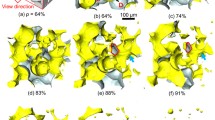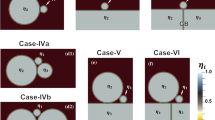Abstract
Quantitative paths of microstructural change, represented as a variation of topological and metric properties with pore volume fraction, were experimentally determined by applying quantitative microscopy to sequences of samples sintered without compaction from two size fractions of spherical copper powder, and one size fraction of dendritic copper powder. The two spherical size fractions followed paths of microstructural change during sintering that were identical except for a scale factor. The connectivity of the pore network first increased slightly, then decreased, reaching zero at a pore volume fraction (V V ) of about 0.08. Isolated pores begin to appear atV V = 0.20, and increased in number. The area of the pore-solid interface at first decreased slowly, then more rapidly and ultimately linearly with pore volume fraction, as has been reported in other systems. Total curvature of pore-solid interface decreased from the positive value characteristic of the loose powder stack to a negative value, passed through a minimum, and increased toward zero as full density is approached. The area of grain boundary initially increased slowly, as interparticle contacts grew; at aboutV V = 0.15, grain growth set in, and the grain boundary area decreased, as the mean grain intercept rapidly increased with densification.
The dendritic powder had a highly irregular surface shape, and consequently a loose stack structure containing more than 90 pct porosity. The path that it followed was qualitatively, but not quantitatively, similar to that observed for the spherical powders.
These observations are discussed in terms of the unit geometric processes that dominate each of the three stages of loose stack sintering.
Similar content being viewed by others
References
R. T. DeHoff and F. N. Rhines:Quantitative Microscopy, McGraw-Hill Book Co., NY, 1968.
R. T. DeHoff, E. H. Aigeltinger, and K. R. Craig:J. Microsc, 1972, vol. 95, p. 69.
L. K. Barrett and C. S. Yust:ORNL Report No. 4411, 1969.
F. N. Rhines:Reutte Plamee Proc. Third Seminar, p. 38, Reutte/Tyrol, 1958.
J. Kronsbein, L. J. Buteau, Jr., and R. T. DeHoff:Tram. TMS-AIME, 1965, vol. 233, p. 1965.
E. E. Underwood:Quantitative Stereology, Addison Wesley Publishing Co., Reading, MA, 1970.
P. K. McGeary:Perspectives in Powder Metallurgy, vol. 2, H. K. Hausner, K. H. Roll, and P. K. Johnson, eds., p. 211, Plenum Press, NY, 1967.
J. D. Bernai and J. Mason:Nature, 1960, vol. 188, p. 910.
R. T. DeHoff, R. A. Rummel, A. H. Long, and F. N. Rhines:Powder Metallurgy, p. 31, Interscience, NY, 1962.
R. T. DeHoff and F. N. Rhines: AEC Contract No. AT-(40-l)-2581, Final Report, December 1969.
R. T. DeHoff, R. A. Rummel, H. P. LaBuff, and F. N. Rhines:Modern Development in Powder Metallurgy, vol. 1, p. 310, Plenum Press, NY, 1966.
R. Coble:J. Amer. Ceram.Soc, 1958, vol. 41, p. 55.
Author information
Authors and Affiliations
Rights and permissions
About this article
Cite this article
Aigeltinger, E.H., DeHoff, R.T. Quantitative determination of topological and metric properties during sintering of copper. Metall Trans A 6, 1853 (1975). https://doi.org/10.1007/BF02646849
Received:
DOI: https://doi.org/10.1007/BF02646849




